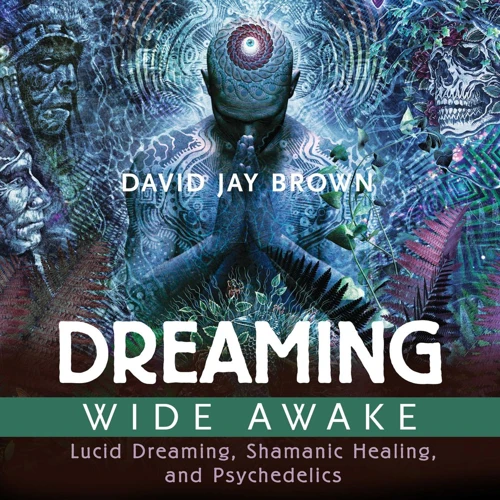Have you ever had a dream where you felt like you were in control, like you were the director of your own personal movie? If the answer is yes, you may have experienced lucid dreaming. This phenomenon, where the dreamer is aware that they are dreaming and can manipulate the dream world, has been gaining popularity in recent years. But did you know that lucid dreaming can also be a tool for spiritual awakening? Many people believe that by incorporating spiritual practices into their lucid dreams, they can facilitate personal growth and self-discovery. In this article, we will explore the connection between lucid dreaming and spiritual awakening, and provide tools and techniques for those interested in exploring this fascinating realm of consciousness.
Lucid Dreaming

Have you ever found yourself aware that you were dreaming within a dream? That’s the concept of lucid dreaming, where you have conscious control over your dreams. It’s a fascinating phenomenon that has been explored for centuries, and now has become a popular topic in scientific research. Some experts have even connected lucid dreaming with spiritual growth and awakening, which is what we’ll be exploring in this section. Let’s dive into the world of lucid dreaming and discover what it is, how it works, and how you can benefit from it.
What is Lucid Dreaming?
Lucid dreaming is a fascinating phenomenon that occurs during our sleep cycles, where the dreamer becomes aware that they are dreaming and can control the dream’s direction and outcome. This level of consciousness during sleep can be a powerful tool for personal growth and enlightenment.
Below is a table summarizing the key points of what lucid dreaming is:
| Awareness | The dreamer is aware that they are dreaming |
| Control | The dreamer can control the dream’s direction and outcome |
| State | Occurs during REM sleep |
| Experience | A vivid and memorable dreaming experience |
| Benefits | Potential for personal growth and self-awareness |
Lucid dreaming is a learned skill that anyone can develop with practice and patience. It can be a powerful tool for unlocking the potential of our unconscious minds and exploring our inner selves. In the next section, we will explore some techniques for lucid dreaming.
How to Lucid Dream
Lucid dreaming is an amazing phenomenon that allows us to control our dreams and experience them more fully. Here are some proven techniques to help you achieve lucid dreaming:
- Reality Checks: This technique involves performing regular “reality checks” while you’re awake. This helps you improve your self-awareness and can also carry over into your dreams. Some examples of reality checks include pinching yourself, looking at your reflection, or trying to fly. If you regularly perform these checks while you’re awake, you’re more likely to do them during a dream and realize that you’re dreaming.
- Meditation: Practicing meditation can help you focus your mind and be more aware of your thoughts and feelings. This can carry over into your dreaming state, making it easier to recognize when you’re in a dream.
- Dream Journaling: Keeping a dream journal is a helpful way to train your brain to remember your dreams. Write down your dreams each morning, even if you don’t think they’re important. Over time, this will help you remember more details and can help you recognize patterns or themes in your dreams.
- Visualize: During the day, spend some time visualizing yourself becoming lucid in a dream. Imagine yourself realizing that you’re dreaming and then taking control of the dream. By regularly visualizing this scenario, you’ll be more likely to experience it when you’re actually dreaming.
- Wake-Back-to-Bed: This technique involves setting an alarm to wake up several hours after you fall asleep, then going back to bed with the intention of having a lucid dream. When you wake up, spend some time focusing on your intention to have a lucid dream before going back to sleep. This technique can be especially effective if you combine it with other techniques like reality checks and visualization.
Remember that achieving lucid dreaming takes practice and patience. It may take some time to find the techniques that work best for you, but with consistent effort, you can start to experience the amazing benefits of lucid dreaming.
Benefits of Lucid Dreaming
Lucid dreaming has several benefits that can enhance both mental and physical wellbeing. Here are some notable examples:
- Improved creativity: During lucid dreams, you have the power to control and manipulate your surroundings, which can stimulate your imagination and creativity.
- Reduced anxiety: Lucid dreaming can serve as a safe and controlled environment to confront and conquer your fears and anxieties.
- Better problem-solving skills: By practicing problem-solving scenarios in a lucid dream, you can improve your critical thinking and decision-making skills in real life.
- Enhanced self-awareness: Lucid dreams can provide you with an opportunity to explore and understand your inner self on a deeper level.
- Improved sleep quality: The ability to control and manipulate your dreams can lead to more restful and rejuvenating sleep.
- Increased self-confidence: Accomplishing goals and facing challenges in a controlled dream environment can boost your self-esteem and confidence in real life.
- Enhanced spiritual growth: Lucid dreaming can facilitate spiritual growth by providing a platform for exploring deeper aspects of consciousness and connecting with higher states of awareness.
Lucid dreaming has the potential to enhance various aspects of your life by helping you unlock your creative, introspective, and problem-solving abilities, while also reducing anxiety, boosting self-confidence, and promoting spiritual growth.
Spiritual Awakening

Exploring the depths of consciousness and the essence of our inner selves is a journey that takes us beyond the physical realm. While many may associate spirituality with organized religion or ritualistic practices, there is a more profound aspect of spiritual awakening that goes beyond any set of beliefs or dogmas. This transformational process involves a profound shift in our perception and awareness, leading to an entirely new perspective on life. It can be sparked by different experiences such as meditation, intense emotional and psychological turmoil or even lucid dreaming. With the potential to change our lives for the better, spiritual awakening offers a glimpse of our true selves and the connection we share with the world around us.
What is Spiritual Awakening?
Spiritual Awakening is a process of profound transformation that leads to a new level of understanding and consciousness. It is a path of self-discovery and inner exploration that transcends the limitations of the physical world. Some people may experience Spiritual Awakening through religious practices, while others may discover it through meditation or other spiritual practices.
Here are some key characteristics of Spiritual Awakening:
- Shift in consciousness and perception of reality
- Increased awareness of the interconnectedness of all things
- Emotional healing and release of past traumas
- Greater sense of compassion and empathy for all beings
- Heightened intuition and inner wisdom
- Deeper understanding of the true nature of existence
Spiritual Awakening is a journey that can be both beautiful and challenging. It involves letting go of old beliefs and patterns of behavior that no longer serve us, and embracing a new way of being. This can bring up a lot of emotions, including fear, anxiety, and uncertainty. However, the rewards of this journey can be truly life-changing, as we discover a whole new level of meaning, purpose, and fulfillment in life.
The Stages of Spiritual Awakening
Spiritual awakening can be a transformative experience that shifts one’s perspective on life and the world around us. While the process of spiritual awakening is different for everyone, there are typically several stages that people go through. Here are some of the stages of spiritual awakening:
- Stage 1: The Call – This is the initial stage of spiritual awakening where a person may feel a sense of disconnect from their current life or a desire for something more meaningful. This feeling is often accompanied by a sense of restlessness or dissatisfaction with the current state of affairs.
- Stage 2: The Awakening – This stage is marked by a sudden realization or epiphany that something needs to change. The awakening can come in the form of a major life event, such as the loss of a loved one or a near-death experience, or it can be a gradual process of introspection and self-discovery.
- Stage 3: The Dark Night of the Soul – This stage is characterized by a period of intense emotional turmoil and crisis. The individual may experience feelings of depression, anxiety, or despair as they confront difficult truths about themselves and their place in the world.
- Stage 4: The Purification – In this stage, the individual begins to shed old patterns of behavior and thought that no longer serve them. This can be a painful process as they confront their deepest fears and vulnerabilities, but it is necessary for true spiritual growth.
- Stage 5: The Illumination – This stage is marked by a newfound sense of clarity and understanding. The individual gains a deeper appreciation for the interconnectedness of all life and may experience a sense of oneness with the universe.
- Stage 6: The Integration – In this final stage, the individual fully integrates their spiritual experiences into their daily life. They may have a renewed sense of purpose and direction, and they may feel called to share their wisdom and insights with others.
It’s important to note that these stages are not linear and that individuals may move back and forth between them throughout their spiritual journey. Each stage offers its own unique challenges and rewards, and it’s important to approach the process of spiritual awakening with an open mind and a willingness to explore the unknown.
Benefits of Spiritual Awakening
The benefits of spiritual awakening cannot be overstated. It is a journey of self-discovery that leads to inner peace and fulfillment. The following table highlights some of the major benefits:
| Benefit | Description |
| Greater sense of purpose | Spiritual awakening helps individuals discover their purpose in life and align their actions with their values, creating a deeper sense of meaning and fulfillment. |
| Increased compassion | As individuals become more in tune with their spiritual selves, they often develop a greater sense of empathy and compassion towards others. |
| Reduced stress and anxiety | Spiritual practices such as meditation and mindfulness can help individuals reduce stress and anxiety by calming the mind and increasing awareness. |
| Improved relationships | By developing greater compassion and empathy, individuals may find that their relationships with loved ones and others improve. |
| Greater self-awareness | Spiritual awakening leads to greater self-awareness and introspection, allowing individuals to identify and address negative patterns or behaviors. |
| Increased creativity and intuition | As individuals tap into their spiritual selves, they may find that their intuition and creativity are heightened, leading to new ideas and experiences. |
| Improved physical health | There is evidence to suggest that spiritual practices can improve physical health by reducing stress and inflammation and improving sleep quality. |
Spiritual awakening can have a profound impact on an individual’s well-being and quality of life, making it a worthwhile pursuit for anyone seeking personal growth and fulfillment.
The Connection

As we delve deeper into the topic of lucid dreaming and spiritual awakening, it becomes apparent that these two concepts are intimately connected. They share a profound relationship that can enhance one’s personal growth and lead to a deeper understanding of the self and the universe. Understanding how lucid dreaming facilitates spiritual awakening is a key aspect of unlocking this connection. Recognizing the potential for spiritual practices within lucid dreams can not only lead to transformative experiences, but also help to incorporate these practices into our waking life.
How Lucid Dreaming Facilitates Spiritual Awakening
Lucid dreaming can play an instrumental role in facilitating spiritual awakening. Here are some ways how it does so:
1. Expanded Awareness: Lucid dreaming allows us to transcend the limitations of waking reality and enter realms of boundless possibility. This provides a new level of awareness that can bring insights into our spiritual journey.
2. Access to the Unconscious Mind: In lucid dreams, we have direct access to our unconscious mind, which is often the source of our deepest fears, desires, and inner conflicts. Exploring these aspects of ourselves can lead to greater self-awareness and spiritual growth.
3. Practicing Spiritual Skills: Lucid dreams offer a safe and controlled space to practice spiritual skills such as visualization, meditation, and energy work. This can help prepare us for using these techniques in waking life.
4. Meeting Spirit Guides: It’s not uncommon to encounter spirit guides or other beings in lucid dreams. These encounters can provide valuable guidance and insight into our spiritual journey.
5. Integration of Spiritual Experiences: Lucid dreams can help integrate spiritual experiences that may be difficult to process in waking life. This can lead to a deeper understanding and integration of these experiences into our daily lives.
Lucid dreaming provides a unique and powerful tool for spiritual awakening. By exploring this realm of consciousness, we can gain deeper insights into ourselves, our spiritual journey, and the nature of reality.
Examples of Spiritual Practices in Lucid Dreams
Lucid dreaming is a powerful tool for not only exploring and understanding oneself, but also for spiritual growth and development. Through lucid dreaming, individuals can engage in a variety of spiritual practices and experiences that can facilitate personal growth and promote overall well-being. In this section, we will explore a few examples of spiritual practices that can be done within a lucid dream.
One example of a spiritual practice that can be done within a lucid dream is meditation. In a lucid dream, one can enter into a peaceful setting and engage in mindfulness meditation. This can help individuals not only relax but also gain insight into their thoughts and emotions.
Another spiritual practice that can be done within a lucid dream is visualization. This involves visualizing positive outcomes or goals while in a lucid dream state. This can help individuals create a sense of direction and purpose in their waking lives.
A third spiritual practice that can be done within a lucid dream is prayer. In a lucid dream, individuals can connect with a higher power or their own inner spirituality through prayer. This can bring about a sense of peace and comfort.
Lastly, individuals can engage in energy work within a lucid dream. This involves focusing on the flow of energy within one’s body or the environment within the dream. By working with energy, individuals can promote healing and balance within themselves and the world around them.
There are countless spiritual practices that can be done within a lucid dream. Through these practices, individuals can gain insight into themselves and the world around them in a unique and powerful way.
Tools and Techniques

In order to successfully experience lucid dreaming and aid in spiritual awakening, it’s important to utilize various tools and techniques that can help enhance the process. By incorporating these techniques into your daily routine, you can improve your chances of having lucid dreams and accessing deeper levels of spiritual insight. Here are some effective tools and techniques that you can use to make the most of your lucid dreaming and spiritual growth journey:
Dream Journaling
Keeping a dream journal is an essential practice for anyone interested in exploring the connection between lucid dreaming and spiritual awakening. Dream journaling involves recording our dreams in detail as soon as we wake up. Here’s why you should start keeping a dream journal:
- Improves dream recall: Dream journaling helps us remember our dreams more vividly. When we write down our dreams, it sends a signal to our brain that dreams are important, and we want to remember them.
- Spotting patterns and symbols: By recording our dreams in a journal, we can identify patterns, recurring symbols, and themes that often appear in our dreams. It can give us insight into our psyche and help us work through unresolved emotional issues.
- Facilitates lucid dreaming: Dream journaling can also help us become lucid in our dreams. By taking the time to write down our dreams, we become more aware of the details and anomalies, making it easier to recognize when we’re in a dream state.
When it comes to dream journaling, you should follow some best practices to get the most out of the experience. Keep a pen and paper close to your bed, so you can write down your dreams as soon as you wake up. Write in detail, describing the setting, people, emotions, and sensations you experienced in your dream. Don’t worry about grammar or spelling; the important thing is to capture as much detail as possible.
It’s also useful to review your dream journal regularly. You may notice patterns, symbols, or themes that emerge over time, revealing deeper insights into your psyche. Dream journaling is an effective tool for unlocking the mysteries of the subconscious, strengthening the connection between lucid dreaming and spiritual awakening.
Meditation and Affirmations
One of the tools and techniques that can be used for both lucid dreaming and spiritual awakening is meditation and affirmations. These practices are both ways to quiet the mind and focus on positive thoughts and intentions.
Meditation involves sitting or lying down in a quiet space and focusing on your breath or a mantra, allowing your thoughts to pass by without attaching to them. This practice can help you become more aware of your thoughts and emotions and promote a sense of inner peace and calmness. It can also help you develop a deeper connection with your inner self and the world around you.
Affirmations, on the other hand, involve repeating positive statements to yourself, either out loud or in your mind. These statements can be focused on personal growth, healing, or manifesting your desires. By repeating these affirmations regularly, you can reprogram your subconscious mind and shift your energy towards more positive outcomes.
In the context of lucid dreaming, meditation and affirmations can be used to set intentions for your dream experience or to enhance your ability to become lucid. By practicing these techniques during waking life, you can create a habit of mindfulness and focus that can carry over into your dream state. This can also help you develop a greater awareness of your dreams and the messages they may hold.
For spiritual awakening, meditation and affirmations can be powerful tools for personal growth and self-discovery. By quieting your mind and focusing on positive intentions, you can cultivate a deeper sense of connection with your higher self and the universe. Affirmations can also help you shift any limiting beliefs or negative self-talk that may be holding you back from spiritual growth.
Incorporating meditation and affirmations into your daily routine can be a simple yet powerful way to enhance both your dreaming and spiritual practices. Here is a table summarizing the benefits of both meditation and affirmations:
| Meditation | Affirmations |
|---|---|
| Reduces stress and anxiety | Reprograms subconscious mind |
| Promotes inner peace and calmness | Shifts negative self-talk to positive |
| Develops mindfulness and focus | Cultivates a positive mindset |
| Increases self-awareness and personal growth | Manifests desires and goals |
Reality Checks and Visualization
Reality checks and visualization are two powerful techniques that can greatly enhance your lucid dreaming and spiritual awakening practice.
Reality checks involve regular questioning of one’s reality during the waking hours, so that when dreaming, the same questions will be asked, and you will more easily recognize that you are in a dream state. Some popular reality check methods include:
- Counting fingers: Throughout the day, count the number of fingers on your hand, and question whether you are awake or dreaming.
- Pushing fingers through the palm of your hand: This simple test helps you to be more aware of your physical senses, and encourages you to be more mindful in your waking state.
- Reading written material: Try to read something every day and ask yourself if you are dreaming. In dreams, words and language can be incoherent or indecipherable, making this a good way to check your reality.
Visualization can help to activate your imagination and facilitate spiritual growth. This technique involves creating a mental image of a desired outcome or state, and holding that image in your mind until it becomes real to you. Here are some tips for using visualization in your lucid dreaming practice:
- Create a clear picture in your mind: Whether it’s a specific location or an ideal state of being, visualize it as vividly as possible, using all of your senses.
- Positive affirmations: Repeat positive affirmations to yourself as you visualize, such as “I am free” or “I am loved.”
- Be open to possibility: Don’t limit your imagination. Anything is possible in your dreams, so be bold and creative in your visualizations.
Both reality checks and visualization require consistent practice to be effective, but with time and dedication, these techniques can greatly enhance your lucid dreaming and spiritual growth practice.
Tips and Precautions
As with any practice related to spiritual growth, lucid dreaming requires some precautions and knowledge of potential risks. In this section, we will explore some tips and best practices to help you navigate the world of lucid dreaming safely and effectively. Additionally, we will discuss some potential risks associated with lucid dreaming and how to avoid them. By following these guidelines, you can enhance your spiritual awakening journey and avoid any negative consequences. Let’s dive in.
Best Practices for Lucid Dreaming and Spiritual Growth
When it comes to lucid dreaming and spiritual growth, there are certain best practices that can enhance the experience and promote personal development. These practices include:
| Practice | Description |
| Dream Journaling | Keeping a record of your dreams can help you identify recurring themes or symbols that may have deeper meaning. It can also increase dream recall and help you become more aware of your subconscious mind. |
| Meditation and Affirmations | Regular meditation practice can help quiet the mind and improve focus and awareness, making it easier to achieve lucidity in dreams. Affirmations can also be helpful for setting intentions before sleep and promoting positive beliefs. |
| Reality Checks and Visualization | Performing reality checks throughout the day can help establish a habit of questioning reality and increase the likelihood of becoming lucid in dreams. Visualization can also be a powerful tool for setting intentions and exploring inner worlds. |
It’s important to note that everyone’s experiences with lucid dreaming and spiritual growth will be unique, and what works for one person may not work for another. It’s also important to approach these practices with caution and respect for their potential power. It’s recommended to seek guidance from a qualified spiritual teacher or mental health professional if you have any concerns or questions. Incorporating these best practices into your daily routine can help foster a greater sense of self-awareness and spiritual growth.
Potential Risks and How to Avoid Them
Lucid dreaming, like any practice, comes with potential risks that should be acknowledged and addressed. Here are some of the possible risks and how to avoid them:
| Risks | Precautions |
| Nightmares or Sleep Paralysis | Start with short lucid dreaming sessions, and prioritize self-care and stress reduction before bed. Additionally, try not to fall asleep on your back, which can increase the likelihood of sleep paralysis. |
| Confusion between Reality and Dream World | Be mindful of your environment and surroundings, and use reality checks to confirm whether you are awake or dreaming. It may also be helpful to have a designated reality check for when you first wake up. |
| Over-Reliance on Lucid Dreaming for Spiritual Growth | While lucid dreaming can be a powerful tool, it is only one element of a spiritual practice. Make sure to also engage in other spiritual practices, such as meditation, journaling, and self-reflection. |
| Ignoring Potential Psychological Issues | Lucid dreaming should not be used as a substitute for professional therapy. If you have underlying psychological issues, make sure to seek appropriate help and support before attempting lucid dreaming. |
| Physical Injury or Accident from Sleepwalking | If you are prone to sleepwalking or have a history of sleep disorders, it is best to avoid lucid dreaming until you can address those issues. Additionally, make sure your sleeping environment is safe and free of obstacles. |
It is important to approach lucid dreaming with caution and respect, taking necessary precautions to ensure both spiritual growth and physical safety. With proper preparation and guidance, lucid dreaming can be a transformative practice for those seeking spiritual awakening.
Conclusion
After exploring the connection between lucid dreaming and spiritual awakening, it is clear that there is a significant overlap between the two states of consciousness. Lucid dreaming allows individuals to tap into their subconscious mind, which can reveal hidden truths and insights about themselves and the world. Likewise, spiritual awakening involves diving deep into the inner self to gain a deeper understanding of one’s purpose and connection to the universe.
By practicing lucid dreaming techniques and using them as a tool for spiritual growth, individuals can experience profound benefits. They may gain insight into their deepest desires and fears, connect with higher realms of consciousness, and experience a sense of unity and interconnectedness with all beings. Additionally, they may use lucid dreaming as a platform for spiritual practices, such as meditations, affirmations, and visualizations.
However, it is important to approach lucid dreaming and spiritual awakening with caution and intentionality. Certain risks may arise, such as experiencing intense emotions or becoming lost in the dream world. To avoid these potential pitfalls, it is recommended to follow best practices for lucid dreaming and spiritual growth, such as setting clear intentions, keeping a dream journal, and practicing self-care.
Overall, by using lucid dreaming as a tool for spiritual awakening, individuals can unlock a deeper understanding of themselves and their place in the universe. The possibilities for growth and transformation are endless when one is open to exploring the vast inner world of the subconscious through lucid dreaming.
Frequently Asked Questions
What is the difference between lucid dreaming and regular dreaming?
Lucid dreaming is when you become aware that you are in a dream while still dreaming, allowing you to have control over the contents of the dream. Regular dreaming is when you experience a dream without being aware that it is a dream.
Can anyone learn how to lucid dream?
Yes, with the right techniques and practice, anyone can learn how to lucid dream.
Is lucid dreaming dangerous?
No, lucid dreaming is not inherently dangerous. However, as with any kind of dreaming, it is important to maintain a healthy sleep schedule and practice good sleep hygiene.
What are some benefits of lucid dreaming?
Some benefits of lucid dreaming include increased creativity, problem-solving abilities, and the ability to confront and overcome fears in a safe environment.
What is spiritual awakening?
Spiritual awakening is a process of becoming more aware of one’s inner self and the interconnectedness of all things, leading to a deeper understanding of the universe and one’s place in it.
Can you have a spiritual awakening without lucid dreaming?
Yes, spiritual awakening is a personal journey and can be achieved through a variety of practices and experiences.
Can lucid dreaming be used as a tool for spiritual growth?
Yes, many people use lucid dreaming as a tool for spiritual growth and exploration. It can be a way to connect with one’s inner self and explore the depths of the subconscious mind.
What are some potential risks associated with lucid dreaming?
Some potential risks include sleep disruption, anxiety, and sleep paralysis. It is important to practice good sleep hygiene and seek professional help if experiencing negative effects.
How can dream journaling help with lucid dreaming?
Dream journaling can help with lucid dreaming by increasing dream recall and allowing you to identify patterns or recurring themes in your dreams. This can help you become more aware when you are in a dream and increase your chances of having a lucid dream.
What is the best way to begin practicing lucid dreaming?
There are many techniques for practicing lucid dreaming, but some popular ones include reality checks, meditation, visualization, and dream journaling. It may take some trial and error to find what works best for you.








